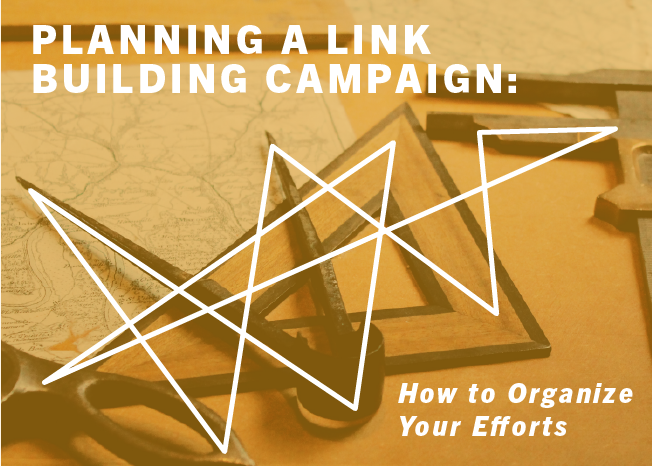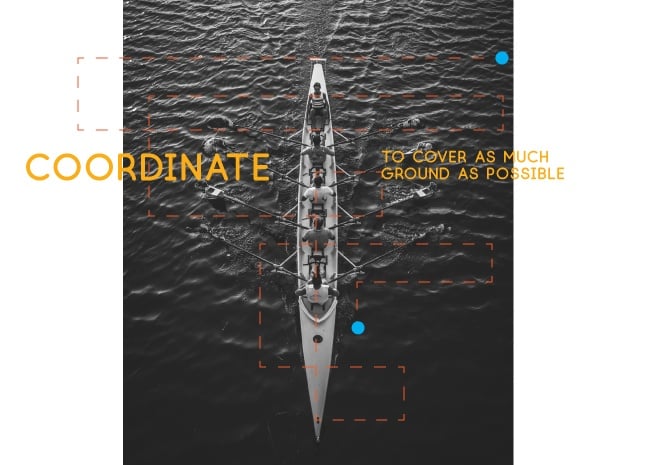Editor's Note: Today's post comes from Tim LeGore-Hand, Research Strategy Specialist here at Page One Power. In this behind the scenes look, Tim lays out his process for developing a comprehensive strategy plan for a link building campaign.
Successful link campaigns are targeted, multifaceted, and adaptable; and it all starts with a plan. Take it away Tim!
Searching for target sites, conducting outreach, and measuring results are the core responsibilities of a link building team. However, one of the most challenging aspects of our role is managing and meeting expectations.
Link building can feel intuitive when we’re just matching a client’s most linkable assets with target sites, but how can a team gauge whether or not those efforts are being effectively spent where it matters most?
Before a campaign begins, a team needs to start with a plan in order to discover opportunities and gauge progress. Planning is how a team explores options to kick-start a campaign, and identifies options that will be available to them over the long-term.

At Page One Power, we have a process in place for producing strategic plans to guide our link building campaigns. While we typically put together these plans at the beginning of campaigns, they can be created whenever a link builder wants to assess where they are in their project and how their efforts have aligned with a client’s goals. They are best used when treated as ‘living’ documents, updated to stay in-line with a business’s shifting interests and search growth opportunities.
In this post, I’ll cover the components that go into an effective link building strategy and explain how to create a document to help guide a link campaign.
Part 1: Summary
We start our plans with a summary of who our client is, what they do, general notes about past work (if applicable), and expectations moving forward.

Whether you’re planning a campaign for a client or for your own site, it’s useful to give yourself a bird’s eye view to better understand how this campaign fits in line with your project’s overall goals. We also use this section as a table of contents so that link builders can quickly reference any section that follows.
Your summary can also be extremely helpful when on-boarding link builders who may not be familiar with your project; it should provide context to your campaign. It should answer: “Who are we building links for, and where does this campaign fit with the client’s overall objectives?”
The next section of a link building campaign plan should expand on those objectives.
Part 2: Objectives
In this chapter of the plan, we pull in keyword research and any additional client requirements asked of our team so that our link builders can better understand how our methods will influence the areas that matter most to the client. This section needs to touch on important keyword verticals and high-value landing pages.
We determine important keywords and landing pages by metrics like current ranking, search volume, and how much organic search traffic a given page already sends to our domain. Priority pages are often decided based on a client’s stated goals, though we aim to propose focus pages based on our research when the client does not have a set of goals in mind.

Finally, this section broadly covers the link building tactics we’ll be using based on our team’s findings. These tactics depend on what assets are available on our domain, and how these assets match with potential target sites.
We’ll dig into these tactics more thoroughly in a later section of the plan, but for now we simply want to provide a snapshot of what our campaign will look like in action to illustrate how we’ll accomplish what is required of our campaign.
In the next part of our plan, we explain some of the homework that goes into evaluating client assets. Now that we know what pages are of value to the client and what opportunities exist, we map out these pages in a chapter we call Landing Pages.
Part 3: Landing Pages
We use this section to closely examine landing pages that we identify as the most link-worthy on the client’s site, along with pages we determine to be valuable based on search growth opportunity.
The pages we select are often based on prior experience with certain types of assets. For example, we often quickly recognize the value of assets like resource guides and infographics because we’ve had success with these types of assets in the past.
Our selection of landing pages can also be based on the analysis of prolifically linked pages from competing domains, and having an understanding of what has been successful on our own domain.
By laying out a menu of options for our link builders, we make it easier to match the client’s goals with what we can most reliably execute in our campaign.

We can also include notes in this section about pages that may not necessarily be valid link assets but provide additional value that could help link builders while conducting outreach, like contact information or “About Us” pages. We can also cover pages that might work as link assets with future on-page updates and optimization.
Now that we know what the client needs, and the pages we need to focus on in order to reach those objectives, next we determine some tactics we can use to begin our work.
We call the next part of our plan Link Opportunities.
Part 4: Link Opportunities
Here we cover some specific site finding methods, such as search strings we can test or competitors we can backlink.
With these methods, we can match the link assets we uncovered in our Landing Pages chapter with target sites. This section should specifically illustrate how these sites are found, and how outreach should be conducted with notes and sample templates.

This section can be valuable when a project is being shared with multiple link builders, who may want to coordinate so as to cover as much ground possible — strategically speaking — while maintaining an overall focus on the client’s objectives.
Diversifying our strategies at the start of a campaign allows us to be more flexible and well-informed about what works when another pivot becomes necessary.
Now that we’ve covered the groundwork of what our campaign will look like in practice, we end our reports with a section providing link builders a place to discover new angles as our campaign moves forward. This is accomplished by reviewing our competitors, whose own link building strategies can help us determine what works in our niche.
Part 5: Competitors
Competitive analysis is a huge part of starting and executing a successful link building campaign. Comparing competing domains can reveal broad strategies to explore in the future, and provide specific target sites we can reach out to in our own efforts.

When deciding on what competitors to include, we check main organic search competitors through tools like SEMRush, and identify competitors for specific priority keywords and landing pages
This section is almost like a to-be-continued for a strategy report; since competitors will always be employing different strategies, and it’s very likely an initial report won’t cover every good link building idea there is to explore.
Our plans conclude with a set of competitors along with sample backlink portfolios so we can continue to explore new ideas through these domains in the future.
Review
When all of these pieces are in place, you set yourself up for success.

To summarize, a link building campaign plan should:
- Identify the client and their objectives.
- Determine what our most relevant and effective link assets are for our campaign.
- Illustrate specific tactics to match landing pages with target sites.
- Forecast future direction in our campaign through competitive analysis.
With a plan in place, we can more effectively determine what paths to take and evaluate which tactics work best.
Whether you’re just starting a campaign or pivoting in a new direction, a document like this can be extremely helpful for making sure your efforts are organized, and are being spent where it matters.
With all of this being said, planning a campaign takes a lot of work. And while it may be tempting to readjust a campaign with a business’s constantly shifting priorities, you’ll unlikely see much progress if you can’t maintain focus.
For search growth to happen, link builders need space to make it happen. We need time to determine if our tactics are effective in fostering higher keyword rankings and increased organic search traffic growth.
How do you plan for a successful link building campaign? Is there anything else you would include in a planning document? Leave your thoughts in a comment below, or share with our team on Twitter at @PageOnePower.
This blog post is based on a transcript of the Page One Power webinar, “How and When to Pivot Link Building Campaigns”. To check out past recorded webinars hosted by Page One Power, visit us on Youtube.

